Transmittal Certificate
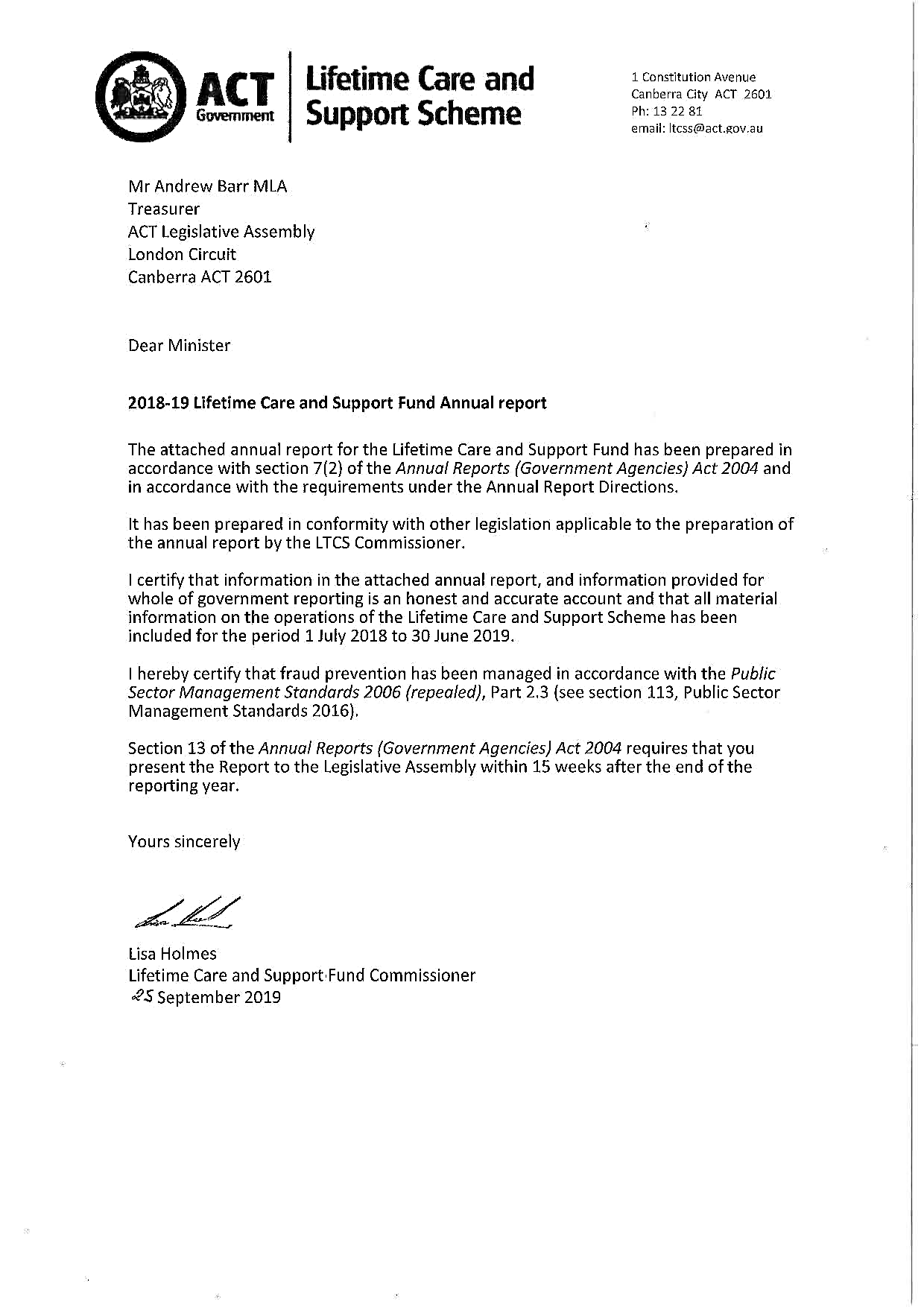
Performance Reporting
B.1 Organisational Overview
The Lifetime Care and Support Scheme (LTCS Scheme) is established under the Lifetime Care and Support (Catastrophic Injuries) Act 2014 (LTCS Act) and provides reasonable and necessary on-going treatment and care to people who have been catastrophically injured as a result of a motor accident or private sector work accident in the Australian Capital Territory (ACT). The types of injuries covered by the Scheme are spinal cord injuries, traumatic brain injury, amputations, severe burns and permanent blindness (more information can be found at http://apps.treasury.act.gov.au/ltcss).
The Scheme covers pedestrians; cyclists; and people travelling on, or in motor bikes and motor vehicles as long as there is at least one registrable vehicle involved in a motor accident that occurs on or after 1 July 2014, regardless of who is at fault for the accident. As a result, it extends motor vehicle accident coverage for catastrophic injuries beyond what is currently available under Compulsory-Third Party (CTP) Insurance to include people who may be considered to be at-fault, or someone who is involved in a single vehicle accident, or even a blameless accident.
The Scheme also applies to catastrophic private sector work injuries that occur from 1 July 2016.
As it is a no-fault scheme, the LTCS Scheme reduces the stress on those injured and their families associated with litigating claims to meet ongoing treatment costs. It ensures early access to medical and rehabilitation care. Further, as treatment and care are ongoing, those injured do not have to worry whether a lump sum payment will meet their needs for the rest of their life and whether they will receive the ongoing treatment and care they require.
Examples of treatment and care provided to participants in the Scheme include:
- medical treatment;
- rehabilitation;
- attendant care services; and
- home and transport modification.
For motor accident injuries, the LTCS Scheme is funded by a levy on CTP insurance policies. Private sector work injuries are funded through a separate levy collected from workers’ compensation insurers and self-insurers. The financial operations of the LTCS Scheme are reflected in the LTCS Fund which is a separate financial reporting entity.
The LTCS Act is administered by CMTEDD. Under section 10 of the LTCS Act, the Minister must appoint a public servant as the LTCS Commissioner of the ACT. The position of the Executive Group Manager, Economic and Financial Group (EFG), CMTEDD was re-appointed by the Minister as the LTCS Commissioner for a further period of three years commencing 16 June 2019. The position of the Executive Branch Manager of the Financial Framework Management and Insurance (FFMI) Branch was re-appointed by the Minister as the Acting LTCS Commissioner when the LTCS Commissioner is unavailable, for a further three years commencing 1 August 2019.
The functions of the LTCS Commissioner are supported by the FFMI Branch of EFG, within CMTEDD.
The NSW government provides support for the ACT Scheme. The NSW LTCS Authority (LTCSA) provides coordinated lifetime care and support services on behalf of the LTCS Commissioner to participants in the ACT Scheme. This arrangement commenced 1 September 2015 and gives effect to the Intergovernmental Agreement (IGA) signed by the ACT Government in February 2015 with NSW.
LTCS Commissioner Responsibilities
Under the provisions of the LTCS Act, some of the key responsibilities of the LTCS Commissioner are to:
- provide an indemnity and insurance scheme to respond to and pay assessed treatment and care needs for eligible participants;
- determine the LTCS levy amount separately for both the motor vehicle and work injuries streams;
- issue and monitor guidelines for the LTCS Scheme;
- assess applications for eligibility for Scheme participation; and
- monitor the reasonable and necessary treatment and care needs of participants.
Highlights
The key priorities for the LTCS Commissioner during the 2018-19 financial year were to:
- administer the LTCS Scheme in accordance with the requirements of the LTCS Act and Guidelines;
- monitor how the Scheme is operating, including whether it continues to meet participant expectations;
- continue to improve guidelines and procedures for the efficient and effective delivery of the LTCS Scheme in consultation with our service partners – the NSW LTCSA;
- develop a memorandum of understanding (MoU) with the National Disability Insurance Agency (NDIA) for the exchange of information about LTCS treatment and care expenses of LTCSS participants; and
- undertake investments in accordance with the Fund’s investment strategy.
Against these priorities, the LTCS Commissioner:
- determined, having regard to independent actuarial advice, the LTCS levy for both motor vehicle and work injuries for 2019-20;
- commissioned and received the fourth LTCS participant feedback report on the administration and effectiveness of Scheme services provided to participants, including insights on how aspects of service delivery may be further enhanced;
- provided input into the review of LTCS guidelines undertaken by the NSW LTCSA, given the ACT’s guidelines largely mirror the guidelines of the NSW LTCS Scheme;
- continued to progress a MoU for the sharing of information between the LTCS Commissioner and the NDIA; and
- invested an additional $14 million of funds not required in the short-term in accordance with the approved LTCS Fund investment strategy. The investment portfolio achieved an investment return for the 2018-19 financial year of 9.8%.
Our Participants
Applications to the Scheme
The LTCS Commissioner accepted three motor accident injury applicants as interim participants in the Scheme during 2018-19. Another applicant was accepted as an interim participant on 8 August 2018 following a determination by an independent review panel. The Commissioner had originally declined this motor accident injury application in 2017-18 on the grounds that it did not meet the eligibility criteria for entry into the Scheme. The claimant disputed the Commissioner’s decision, and in accordance with Part 7 of the LTCS Act, the Commissioner referred the matter for assessment by an independent review panel.
During 2018-19, the LTCS Commissioner accepted one new work injury applicant as an interim participant in the Scheme. A further LTCS work application was received just before 30 June 2019 and has since been accepted (6 August 2019) as an interim participant in the Scheme. The associated expenses for this participant are reflected in the LTCS Fund’s financial statements for 2018-19.
As at 7 August 2019, there was only one outstanding application to the Scheme for assessment relating to an accident that occurred after 30 June 2019.
Applying to the Scheme
All participants commence as ‘interim participants’ for up to two years. During this time, the Scheme will pay for any reasonable and necessary treatment, rehabilitation and care related to the motor accident or work injury.
After two years, an interim participant may be eligible to become a ‘lifetime participant’. Children cannot apply for lifetime eligibility until they are at least five years old.
Decisions about whether an interim participant is accepted as a lifetime participant are made before the end of the interim participation period. Around six months prior to the end of the interim participation period, a participant’s eligibility to remain in the scheme is assessed to determine whether the person may have sufficiently recovered to the extent that they no longer meet the eligibility criteria after the two-year period. If it is assessed that the injured person is likely to meet the eligibility criteria beyond two years, the person is accepted into the scheme for life. In 2018-19, one interim participant was assessed and accepted for lifetime participation in the LTCS Scheme.
Applying to the Scheme
As at 6 August 2019 there are 13 participants who are receiving coordinated treatment and care benefits through the scheme. Five are lifetime participants (all of whom are motor injury participants) and eight are interim participants and 10 are motor accident injury participants and three are work injury participants.
The LTCS Scheme continues to have quite a young profile with the average age of participants currently 29 years, slightly higher than last year. Of the 13 participants in the scheme as at 6 August 2019, only one participant is under 10 years of age. Male participants comprise 85% of all participants in the scheme.
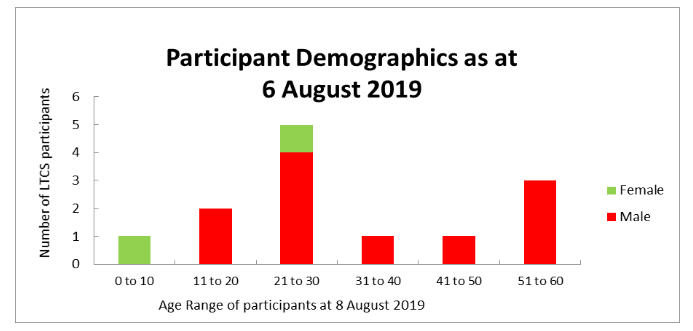
The scheme covers five types of catastrophic injuries – traumatic brain injury, spinal cord injury, amputations, burns and vision loss. Ten participants (77%) have suffered a traumatic brain injury.
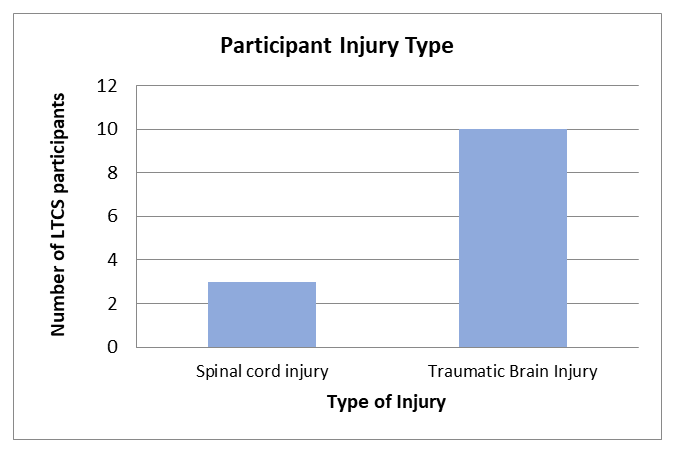
Although three of the participants are work injury participants, they were all injured in a work motor vehicle accident. In terms of how the 13 scheme participants were injured in a motor vehicle accident:
- one was a passenger;
- three were pedestrians (23%);
- one was riding a bicycle; and
- eight were drivers (61.5%), including five motorcycle riders (38.4%).
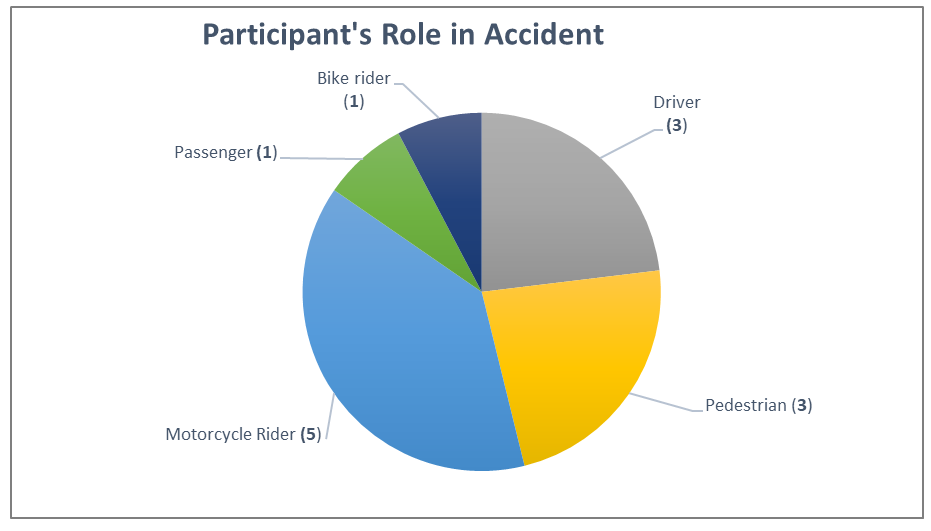
Participants’ perception of the LTCS Scheme support for recovery and rehabilitation goals
Feedback was sought from LTCS work injury participants and their nominated representatives through participant feedback research conducted in May 2019 [1]. This was the first time a survey was conducted to seek the views of work injury participants. Overall participants reported very positive experiences with the scheme and felt grateful to be in the scheme. Some comments from respondents include:
“I’m so happy. The scheme is very helpful and supports me with everything.”
“ Life would be a lot harder without the scheme.”
“I didn’t expect they will support me with everything. I didn’t think it would be quick support”
Participants and/or their nominated representatives reported that the LTCS application and workers’ compensation claim processes operated smoothly and was stress-free. Participants understood the different benefits payable through the workers’ compensation insurance scheme and the LTCS Scheme; and recognised that overall, the different benefits available under the two schemes complemented each other. A participant said:
“The workers’ compensation doesn’t have any impact on my rehabilitation, but they give me money each week.
It pays the rent. If that wasn’t there I’d struggle to pay the rent. Both of them help me in different ways”.
Consistent with previous feedback from motor vehicle injury participants, the participants interviewed were at different stages of their rehabilitation and all felt that their needs were being met. Participants indicated that they were able to access a wide range of services and support; and that their needs were met promptly, as articulated by the following comments:
“… they were very quick. Very helpful. Always quick. They helped me with everything.”
“I have heard stories about other schemes. …This Scheme is helpful. In comparison to
other schemes this one is the best.”
In the participant research undertaken in May 2019, work injury participants were asked about their experiences accessing and using services and equipment, and if there had been any issues with these. Overall, participants were very positive about the services and equipment funded by LTCS Scheme and their experience with the scheme, as reflected by the comment from a representative who was able to observe the impact of the scheme on a participant:
“… He’s a lucky man. I didn’t realise that when he was approved. I didn’t realised how much it entailed.
Seeing over the last 18 months, I realise he could not have coped without the scheme”
Provided Treatment, Rehabilitation and Care
In 2018-19, the LTCS Scheme spent a total of $1.267 million on services for participants (up by 64% compared with the previous year). As expected, given the number of new participants accepted in the year, hospital expenses accounted for a significant proportion (28%) of participant expenses. Attendant care services (30%) was the largest category of participant expenses reflecting the high care needs of some of the scheme’s participants.
The third highest expense category related to support services (19%), which comprises mainly case management fees and travel expenses for participants and service providers to access and provide medical review and treatment. Rehabilitation (6%) and home modification (6%) were the next largest expense categories.
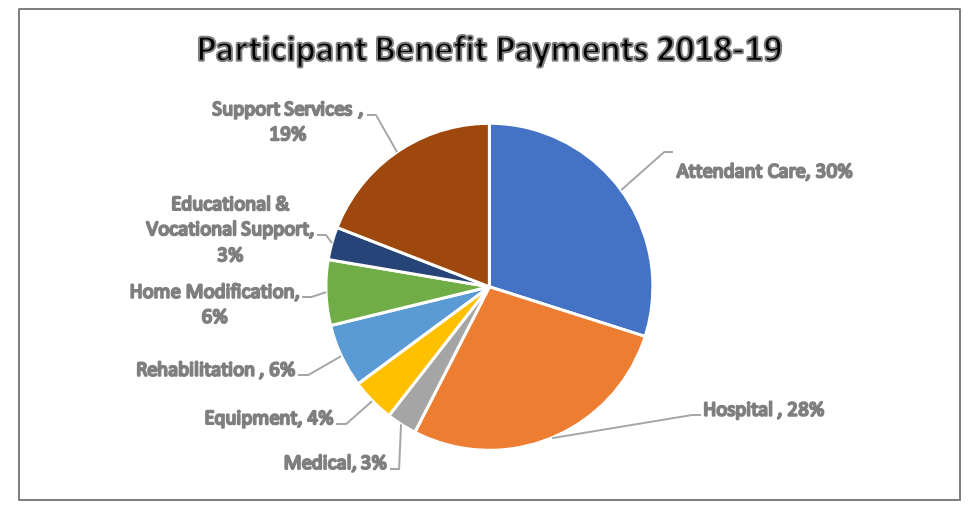
In comparison, in 2017-18, the LTCS Scheme spent a total of $772,105 on services for participants. The largest expenditure category in 2017-18 was for hospital expenses (42%) followed by support services (20%). Rehabilitation (15%) and equipment (13%) were the next largest expense categories.
Accessing Services – How the scheme works with participants
The LTCS Scheme provides reasonable and necessary treatment, rehabilitation and care as it is required throughout the person’s life and assists them to plan their rehabilitation and care services.
Participants are supported as needed by a LTCS Scheme coordinator. The coordinator arranges for a case manager to help plan services required by the participant.
The case manager will work with the participant and their service providers to request approval for services. Services are organised as required and the participant and their families are closely involved in each of these requests. Usually payment of approved treatment and care needs is made by the LTCS Scheme directly to the supplier of the services.
Outlook
Strategic priorities for the LTCS Commissioner in 2019-20 include:
- undertake a five-year review of the LTCS Scheme;
- administer the LTCS Scheme in accordance with the requirements of the LTCS Act and Guidelines;
- review and implement changes to improve the ACT LTCS Guidelines following on from the review of LTCS Guidelines by NSW LTCSA;
- collect annual feedback from participants on their expectations and experience with the LTCS Scheme and in consultation with our service partner, the NSW LTCSA, implement improvements to the way LTCS Scheme benefits are delivered to ACT participants;
- continue to progress development of a MoU with the NDIA for the exchange of information about LTCS treatment and care expenses of LTCS Scheme participants; and
- undertake investments in accordance with the Fund’s investment strategy.
Performance analysis
The LTCSS’ 2018-19 performance indicators are included in the Budget Portfolio Statements for the LTCS Fund and are reported as part of the LTCS Fund’s Statement of Performance.
Explanation of Performance Indicators
a. Independent actuarial review to advise on the required fund contribution
The LTCS levies are crucial to the funding of the Scheme, with a levy applying to all CTP policies payable at the time of vehicle registration and a levy applied to private sector workers’ compensation insurers. As required by the LTCS Act, the levies are set by the LTCS Commissioner based on independent actuarial advice. The level at which the levies are set in any given year is intended to provide sufficient funds to meet the costs of all estimated present and future liabilities of new participants of the LTCS Scheme in that year. The LTCS levies are for a financial year and are set in May/June before the commencement of a financial year on 1 July.
In accordance with section 83 of the LTCS Act, before the beginning of the contribution period the LTCS Commissioner obtained a report from an independent actuary in relation to the amounts needed to be contributed to the LTCS fund for the contribution period.
Two actuarial reports for the 2019-20 contribution period were undertaken by the scheme actuary, Finity Consulting Pty Ltd for the purposes of setting the 2019-20 LTCS Levy for motor vehicle injuries and the LTCS levy for work injuries. The final actuarial reports were received in March 2019.
b. Determine LTCS Levies
The LTCS Commissioner determined that the LTCS levy for a twelve-month CTP policy would be increased to $37.00 in 2019-20 (from $36.50 in 2018-19) for all vehicles except those that are subject to distance restrictions applicable as part of the ACT’s Concessional Vintage Vehicle Registration (CVVR) Scheme. As a result of the increase to the LTCS levy for general passenger vehicles, the LTCS Levy determined for the CVVR Scheme increased to $7.40 in 2019-20 (from $7.30 in 2018‑19) for a twelve‑month CTP policy.
The Levy determination for the 2019-20 contribution period for both motor vehicles and private sector workers’ compensation insurers and self-insurers, was notified on the Legislation Register on 14 May 2019.
The LTCS Commissioner has determined these LTCS levies based on the best available data. As the Scheme will only be in its sixth year of operation for motor vehicle accidents and in its fourth year of operation for work accidents, a high degree of uncertainty remains with respect to the number of participants and the costs of providing services. By the very nature of the injury type covered by the scheme, the costs of the scheme can be expected to be volatile from year to year. Noting that it will take many years of experience before more robust scheme data becomes available, the LTCS Commissioner will continue to reassess the levy amounts yearly, on the basis of updated advice provided by an independent actuary.
c. Undertake an annual participant feedback process
A survey of the LTCS Scheme participants was conducted by Insight Consulting Australia, a social research consultancy that specialises in undertaking research of services in the disability and health sectors, in May 2019. A final report was received in June 2019.
The purpose of the survey was to seek feedback from work injury participants to understand their experience with accessing treatment and care under the scheme. The research also sought participant feedback in relation to their experience with the workers’ compensation insurer scheme claim process and how it interacts with the LTCS Scheme; as well as whether and to what extent the LTCS Scheme has supported their recovery and rehabilitation goals and objectives. Analysis based on the feedback was used to identify opportunities for improvements in the operation of the LTCS Scheme. All LTCS Scheme participants invited to participate agreed to be interviewed as part of the survey.
Overall respondents provided very positive feedback on the extent and manner to which the scheme supports their rehabilitation and ongoing well-being. Participants reported that the application process and engagement with the workers’ compensation scheme and LTCS Scheme were smooth and stress-free. The scheme continues to meet participants’ needs at their individual stage of recovery and rehabilitation and to assist them in meeting their goals. Participants and their families interviewed reported that they felt well-supported by care offered through the scheme and the strong relationship with their case manager and the scheme’s coordinator care team.
Within this positive context, the report offered some key learnings relevant to participants with multiple injuries and complex care needs, in particular, the importance of:
- regular participant follow-up at key intervals to allow services to be fine-tuned and to keep track of participant recovery goals; and
- matching participants who have complex care needs with providers with experience working with clients with similar needs.
As the research considered the administrative processes of the LTCSA, a copy of the research report and key learnings has been provided to the LTCSA and discussed with them.
d. Difference between the investment earning rate and the benchmark is = 0
In 2018-19, the LTCS investment portfolio achieved an investment return of 9.8% (compared to the performance benchmark return of 3.9%). The better than benchmark return was due to positive returns achieved across all asset classes, particularly Australian and International shares. The difference between the actual annual portfolio investment earnings rate and the established performance benchmark is a measure of the relative performance of the investment fund(s) to the benchmark. The measure is calculated by subtracting the benchmark performance from the portfolio’s gross performance. The variance is measured by the percentage difference between the actual performance and the benchmark.
B.3 Scrutiny
During the reporting period the LTCSS did not participate in any Legislative Assembly Committee inquiries related to its activities. There were no Ombudsman Reports.
However, the Auditor-General Report No.1 of 2018: ACT Government Strategic and Accountability Indicators made a number of recommendations that were relevant for the Lifetime Care and Support Fund. In regard to:
- Recommendation 2 (a), the Lifetime Care and Support Fund has been asked to amend accountability indicators to explain how they support achievement of government priorities;
- Recommendation 4, all Territory entities, including the Lifetime Care and Support Fund, have been asked to document their procedure for the review, selection and approval of strategic and accountability indicators; and
- The Fund’s accountability indicators were reviewed as part of the 2019-20 Budget process. The documentation of procedures for reviewing the Fund’s indicators has been undertaken in response to the Auditor General’s Report.
B.4 Risk Management
The LTCSS is part of CMTEDD. As such, it is covered in CMTEDD’s risk management arrangements.
B.5 Internal Audit
The LTCS Commissioner is subject to the oversight of the CMTEDD Audit and Risk Committee. CMTEDD’s Annual Report section on the Internal Audit Committee applies to the LTCS Commissioner.
No internal audits of the LTCS Commissioner were undertaken during 2018-19.
B.6 Fraud Prevention
The functions of the LTCS Commissioner are supported by the Financial Framework Management and Insurance (FFMI) Branch of the Economic and Financial Group (EFG), CMTEDD who adhere to the CMTEDD Fraud and Corruption Prevention Plan.
B.7 Freedom of Information
The LTCS Commissioner does not employ staff. The FOI functions of the LTCS Commissioner are supported by the Information and Access Team of the Corporate Group, CMTEDD.
B.8 Community Engagement and Support
The 2018-19 CMTEDD Annual Report’s section on Community Engagement and Support applies to the LTCS Commissioner.
B.9 Aboriginal and Torres Strait Islander Reporting
The CMTEDD’s Annual Report section on Aboriginal and Torres Strait Islander Reporting applies to the LTCS Commissioner.
B.10 Work health and Safety
The functions of the LTCS Commissioner are supported by the FFMI Branch of EFG, CMTEDD who adhere to the directorate’s Workplace Health and Safety practices.
B.11 Human Resource Management
The CMTEDD’s Annual Report section on HR management applies to the LTCS Commissioner.
B.12 Ecological Sustainable Development
The CMTEDD’s Annual Report section on Ecologically Sustainable Development applies to the LTCS Commissioner.
Financial Management Reporting
C.1 Financial Management Analysis
Details of the LTCS Scheme’s 2018-19 Financial Management Analysis are included in Volume 2.2 of the 2018-19 CMTEDD Annual Report.
C.2 Financial Statements
The LTCS Fund’s financial statements are reported in Volume 2.2 of the 2018-19 CMTEDD Annual Report.
C.3 Capital Works
The LTCS Commissioner did not undertake any Capital Works Projects in the 2018-19 financial year.
C.4 Asset Management
The LTCS Commissioner has no intangible assets.
C.5 Government Contracting
The LTCS Commissioner did not enter into any contracts with a value exceeding $25,000 in 2018-19.
C.6 Statement of Performance
The LTCS Fund’s Statement of Performance is included in Volume 2.2 of the 2018-19 CMTEDD Annual Report.
